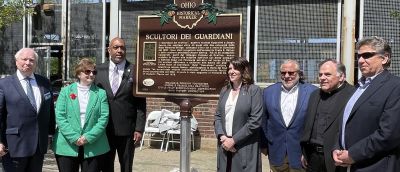L'articolo parla della scultura “Scultori Dei Guardiani” a Cleveland, costruita da immigrati italiani. La città di Cleveland ha recentemente dedicato una targa scritta nei mattoni con il nome della scultura nella lingua italiana ed in inglese. C'è anche una tabella con i nomi dei 19 immigrati italiani che furono gli scultori di questo capolavoro. La presentazione dei nuovi tavoli è avvenuta il 5 maggio ad un evento formale. C'erano quasi 100 persone all'evento e Pamela Dorazio-Dean, direttrice del Museo della Cultura Italo-Americana, è stata la relatrice principale. Padre Joseph Previte ha benedetto i tavoli e le sculture con una preghiera recitata entrambe in italiano ed in inglese.
The legacy of the Italian immigrants who sculpted Cleveland’s iconic Guardians of Traffic is literally written in stone. It is also now officially and permanently recognized by the state of Ohio.
An Ohio Historical Marker, entitled “Sculptors of Guardians” on one side and “Scultori Dei Guardiani” on the other, was unveiled and dedicated during a ceremony on May 5 in Little Italy in Cleveland. The brown, 200-pound, cast aluminum marker stands on Random Road, next to the former site of the Ohio Cut Stone Co., where the Guardians were crafted.
It is the first and, so far, only bilingual marker of more than 1,740 around the state, said Thomas Chema of the Ohio History Connection, formerly the Ohio Historical Society, which administers the marker program. He was one of seven speakers at the hour-long ceremony attended by more than 100 people.
For much of the crowd, the event had the warmth of a family gathering. Executive director Joe Marinucci of the Little Italy Redevelopment Corp., which will be steward of the marker, said that 19 of the more than 20 Italian sculptors came from the town of Oratino, Campobasso, in Molise. All belonged to Unione E Fratellanza Oratinese, a fraternal mutual support society founded in 1924.
The club’s current president, Anthony Pinto, read the names of the 19. His voice thick with emotion, he noted that their work had been forgotten until his godfather, Delfino Mastrangelo, son of one of the carvers, wrote about them in a Little Italy newsletter in the 1980s.
Mary Fatica-Martin came across the story in the Italian American Collection of the Western Reserve Historical Society. The story led her to start and lead the project for the marker, researching and writing the grant application and statement of significance. Credited by every speaker and given a standing ovation by the audience, she called the three-year effort a labor of love honoring her late father, James Gennaro Fatica, who was born in Oratino. She said the marker is “about simple people who had a craft, worked together and made something beautiful.”
Historian Pamela Dorazio-Dean, the keynote speaker, said the “proud but humble, talented Oratinese men were not doing this job for recognition or rewards. They did it because it was what they were trained to do and did it well and with pride because that’s how Italians do things.”
Dorazio-Dean, director of the Italian American Museum of Cleveland and assistant curator of the WRHS Italian American History Collection, said Oratino and the surrounding area had a long tradition of families working in quarries and stone carving. She said sculptor Giuseppe Carabelli became known as the “Father of Little Italy” because he recruited many of these scalpellini, men skilled in working with stone, to work at his Lake View Granite and Monument Works, and helped them settle nearby, in the area previously known as Cleveland’s East End.
The eight massive Guardians of Traffic sculptures are only the best-known work of these artisans, she said. The 43-foot art deco figures have stood sentinel at each end of the Hope Memorial (formerly Lorain-Carnegie) Bridge for 91 years and lent their name and image to Cleveland’s Major League Baseball team after the 2021 season.
“The Guardians are uniquely Cleveland,” said City Council President Blaine Griffin, who worked with Fatica-Martin to have the marker awarded. He said the figures stand as proof that “immigrants get the job done. They did it then and they do it now.”
Father Joseph Previte, pastor of Holy Rosary Church, gave a blessing in English and Italian, and celebrated Mass after the ceremony.
-
 The English side...
The English side...
The English side...
The English side...
-
 Historian Pamela Dorazio-Dean...
Historian Pamela Dorazio-Dean...
Historian Pamela Dorazio-Dean...
Historian Pamela Dorazio-Dean...
-
 Flanking the new...
Flanking the new...
Flanking the new...
Flanking the new...
https://www.lagazzettaitaliana.com/history-culture/10214-state-historical-marker-honors-italian-immigrant-sculptors#sigProId53aff10b22



